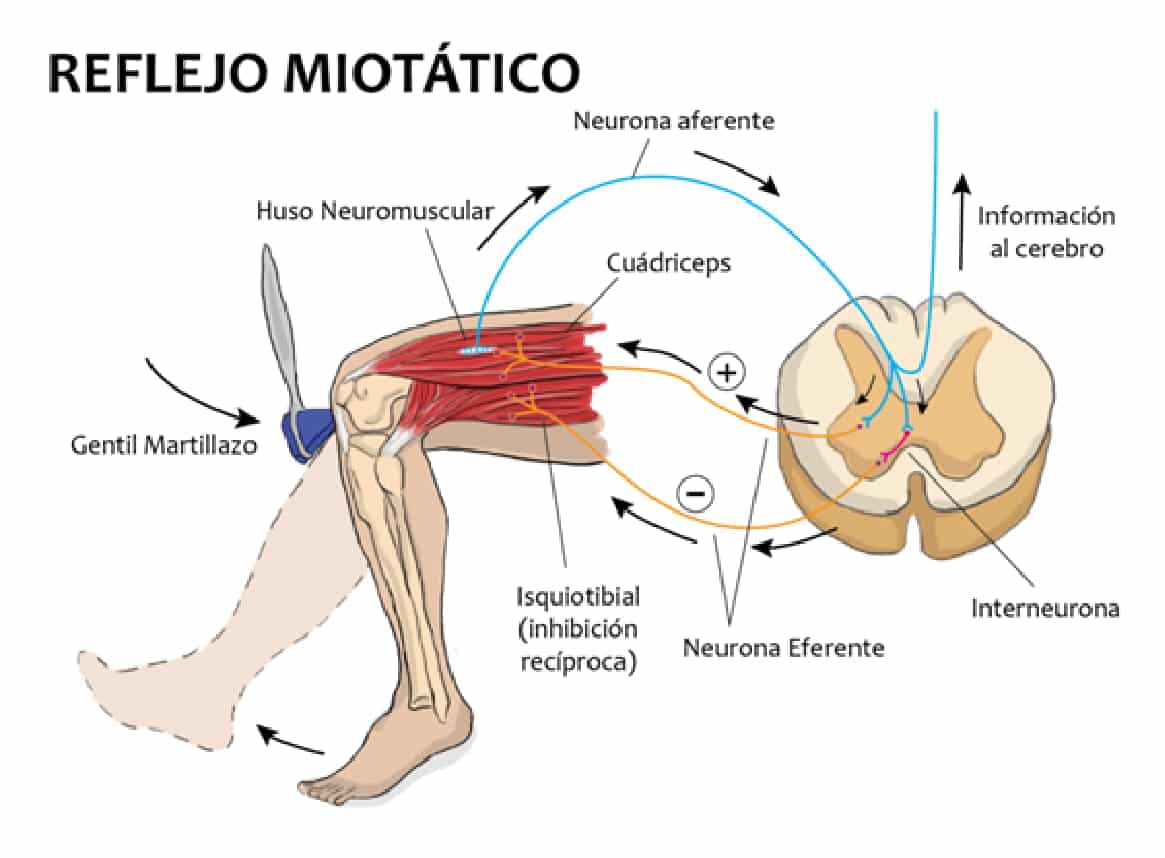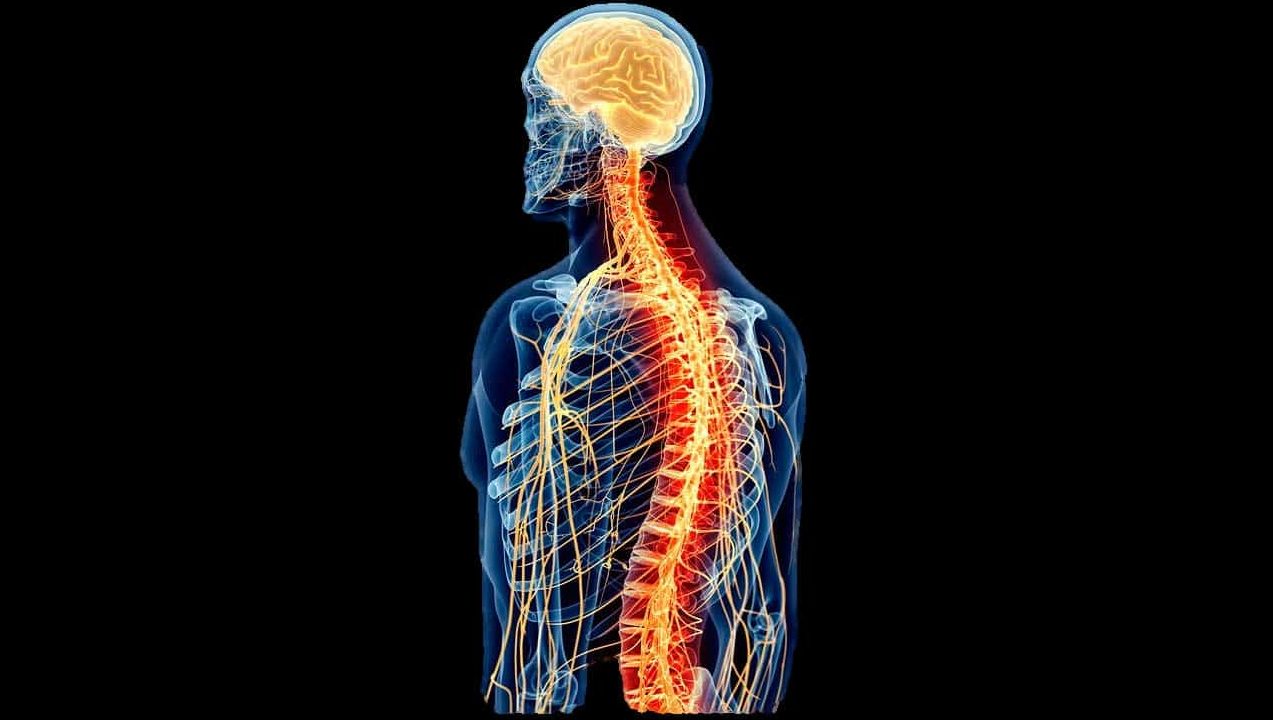25 de February de 2022
How The Myotatic/Stretch Reflex Affects Jumping Force Production
The vertical jump and the horizontal jump are two movements that are present in many sports modalities. This movement and this motor competition can be decisive in the end of a football match, in the last point in a volleyball match and, of course, in the victory in a long jump. It is a movement that, like the race, is present in countless individual and team sports and it is necessary to make an in-depth analysis of how to jump better. In today’s blog we are going to focus on a very important part of the vertical jump, an involuntary reflection of the organism that may or may not help to reach a greater height or a greater length; the myotatic reflex.
What is the myotatic reflex?
There is a defense mechanism of the organism that prevents any muscle breakdown, the so-called myotatic reflex. As his word indicates, the myotatic reflex is an automatic and involuntary signal that the organism causes when it finds that a muscle is stretching too much (1). Unlike in a voluntary contraction our brain sends a signal (efferent) that indicates that the muscle must be activated. So, for example, when we want to do a bicep curl we send a signal to lift the load. However, in the myotatic reflex the brain does not send any signal but it is the spinal cord that is responsible for doing the work. The best proof of the existence of the myotatic reflex is when we burn. Automatically and without us provoking it, the organism understands that a part of the body is burning and produces an automatic signal to move, for example, the hand away from the fire. Once we have set it aside is when our brain understands that we were not burning.
Avery similar thing happens when we are stretching amú sculo. Voluntarily we send the order of the stretch until there comes a time when the spinal cord stops it causing a contraction of the involuntary muscle. The muscle spindle sendsa signal that does not reach the central nervous system (the brain) but stays in the spinal cord and obtains an automatic response. The medulla automatically detects that the muscleis stretching too much and sends a protection signal, nothing more and nothing less, than an involuntary contraction of themuscle (2). This well-programmed involuntary contraction can cause the expression of force after that myotatic reflex to be greater.

Which organ responds to muscle stimulation?
As we have previously loomed, the brain has a great responsibility when it comes to making any movement. In fact, the brain is so important that when a person suffers a stroke or when he has a brain tumor one of the first consequences is usually the lossof mobility. In order for our body to move, it has to constantly send signals from the brain to the rest of the body. And a muscle stimulus was not going to be a stimulus different from the others. The organ responsible for responding to muscle stimulation is the brain. However, as we have said previously with the myotatic reflex there is no voluntary response from the brain so we could not say that the central nervous system is responsible for sending that response. We have already commented previously that in the case of the myotatic reflex, the spinal cord is the part of the body responsible for responding to the stimulation of stretching or pain (3).

The spinal cord is located in the spine and is responsible for our entire body to function. Its function is based on sending the nerve stimuli that leave the brain to the body and receiving those impulses to send them to the brain. Let’s say it has two functions:
- Send the impulses that arrive from the different parts of the body to the brain so that it can process them and give a voluntary response. This is done through the afferent pathways.
- Send the impulses that arrive from the brain to the different parts of the organism where they want to act. This is done through efferent pathways.
However, there are times when it offers automatic responses such as the myotatic reflex.
What is the result of the myotatic reflex?
We have already commented that the result of the myotatic reflex is an involuntary contraction of themuscle. However, this myotatic reflex has different magnitudes. Thus, for example, when a neurological hammer is used and the knee is hit, the myotatic reflex offers a response of a high magnitude since the result is an almost complete extension of the knee. When we bring the hand to a candle and burn the contraction is not only of a muscle group, but the muscles of the hand, arm, shoulder and even the back are activated. That is, the myotatic reflex affects different muscle groups in the same way and with a high magnitude. And, on the contrary, when we are performing a stretch the myotatic reflex only contracts the muscleso that it can not continue to stretch.
However, if we want to use the myotatic reflex as a resource to generate greater muscle contraction we must take that stretch to a high level.
How can the myotatic reflex improve your flexibility?
The myotatic reflex is a response that causes a muscle contraction; therefore, it is difficult to help improve or flexibility. However, it is necessary to explain what relationship exists between the myotatic reflex and flexibility and, above all, to give light to the so-called reverse myotatic reflection.
The first thing to note is that, if the myotatic reflex were so strong and could not be avoided, we could never train flexibility. But the myotatic reflex can be “dodged”. For example, we can see in multiple gym rooms people stretching and making “bounces”, and there is nothing worse for flexibility than these bounces. However, if we perform a stretch and the myotatic reflex is activated, we must hold that position approximately 30 seconds so that the myotatic reflex is “deactivated” and go a little further.

One of the forms of flexibility training is this same. When we have subjected our muscle uses on a regular basis to that stretch, there comes a time when the myotatic reflex loses a few centimeters of stretch until it is activated and allows flexibility or range of motion to increase.
On the other hand, there is the so-called reverse myotatic reflex. Another way to train flexibility is this one we discussed. When we perform a maximum isometric contraction we subject the muscleto a high tension and when the contraction ceases there is a relaxation reflex in themuscle. It is at that moment when we can take the opportunity to go a little further in our stretch and hold the position. In this way we will concatenate stretches and isometric contractions until we reach the range of motion we want. Flexibility is a physical capacity that we must work every day to have good mobility.
How does the myotatic reflex help the production of force in jumping?
Even though we don’t know what is myotatic reflex, we do know the way to jump higher. As living beings we have a series of “unconscious” answers to simple questions. If we want to jump higher we will perform a good descent phase and then be able to jump higher (4).
Our body is intelligent and without us having knowledge about it knows that the greater the eccentric phase of the muscle, the greater the concentric phase it can have and, therefore, it can jump higher. But, nevertheless, in the Vitruve blog we are going to analyze why this is so. As you may have already noticed, the activation of the myotatic reflex can lead to a greater concentric phase and a greater contraction of the muscle (5).. This is mainly due to three mechanisms:
Loading the muscle spindle
In order to activate the myotatic reflex, the first thing we have to do is subject the muscle to a stretching cycle that promotes a “danger” response. In this sense, we must load the muscle spindle by performing a stretching phase to be able to jump higher. We will stretch the buttock and quadriceps performing a hip flexion and a knee flexion.
The stretch-shorten cycle
Elastic energy is also an ally to be able to jump higher. Just as a spring or a hair rubber works when we subject the muscle to a stretch of great magnitude, the force with which it returns to its natural position is greater. Therefore, accumulating elastic energy in the stretching phase plus the activation of the myotatic reflex leads to a much greater jump in height or length.
Optimal shrinkage length
Well, we know that an extension of the muscle prior to a jump will favor a greater jump. How muchshould we elongate the muscle before the jump? Apparently there is a theory that it should be stretched up to 1.2 times its original length. It seems that this length allows a sufficient accumulation of energy without damaging the muscle. If we exceed that length, we can cause some kind of damage.
And how do we know if we’re jumping more?
Once we know the benefits of the activation of the myotatic reflex and its applicability in the vertical jump we must be able to quantify what is the magnitude of that benefit. To do this, we can use the jump height or the speed of the jump and for this we can use the training system based on speed.

The Vitruve device is a tool that measures the speed of execution, but also tells us the range of motion. If, for example, we anchor the device to us and measure the range of motion of the vertical jump we will see that the longer the length, the greater the height.
On the other hand, if we measure through the training device based on speed the execution speed itself, we will see that the higher the speed, the greater the expressed force.
The Vitruve device can help us inour relationships by measuring before and after an intervention for example of 4 weeks and be able to quantify the improvements observed in that time. A plyometric training will surely have benefits when it comes to improving the high jump because it is a training that combines at all times the activation of the myotatic reflex and the shortening stretching cycle.
Conclusion
By way of conclusion, we can say that the existence of the myotatic reflex favors a higher jump. This automatic response of the organism arose as protection against breaks or stimuli that endangered the health of the human being. However, in the world of performance it has been used to improve vertical or horizontal jumping.
On the other hand, if your goal is to improve flexibility you should not forget that your body will oppose that you elongate the muscle more than the account so performing small isometric contractions is a good way to reverse the effect of the myotatic reflex and improve little by little.
Unai Adrián Pérez de Arrilucea Le Floc’h
References
1.Castillo GD, by Jorge JLV. Anatomy and physiology of the central nervous system: Univ Foundation. St. Paul; 2015.
2.Liddell EGT, Sherrington CS. Reflexes in response to stretch (myotatic reflexes). Proceedings of the Royal Society of London Series B, Containing Papers of a Biological Character. 1924;96(675):212-42.
3.Poppele R, Terzuolo C. Myotatic reflex: its input-output relation. Science. 1968;159(3816):743-5.
4.Clutch D, Wilton M, McGown C, Bryce GR. The effect of depth jumps and weight training on leg strength and vertical jump. Research quarterly for exercise and sport. 1983;54(1):5-10.
5.Fletcher IM. The effect of different dynamic stretch velocities on jump performance. European journal of applied physiology. 2010;109(3):491-8.

